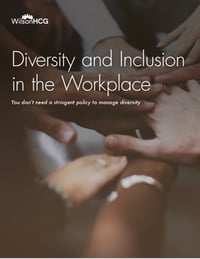You don’t need a stringent diversity and inclusion policy to manage diversity in the workplace
By now, every organization understands the importance of creating a diverse workforce. But, many businesses are still failing to create truly inclusive environments.
Diversity can be accomplished by reaching a certain representative number of employees from various backgrounds but inclusion is about the feeling of belonging that people get when they are in the workplace.
People need to be celebrated — not separated — for their differences. They should be empowered and inspired to bring their unique ideas, experiences, and practices to life. ![]() And to be truly effective, inclusion has to be ingrained and integrated throughout the entire workforce. Everyone within an organization, regardless of job title, department or location, is responsible for making an inclusive workforce happen. It’s a holistic effort that must take a top-down approach and be driven through every interaction, no matter how small.
And to be truly effective, inclusion has to be ingrained and integrated throughout the entire workforce. Everyone within an organization, regardless of job title, department or location, is responsible for making an inclusive workforce happen. It’s a holistic effort that must take a top-down approach and be driven through every interaction, no matter how small.
By creating a safe, respectful environment, individuals will be able to grow and thrive, which will help your organization reach its goals.
Many businesses strive to achieve a diverse and inclusive workforce, but why is it so important?
Put simply, organizations with diverse and inclusive workforces, where people have a sense of belonging, have a competitive edge over those that don’t. A diverse workforce drives change, innovation, and growth, and enhances culture, while an inclusive workforce brings out the best in each employee.
Research shows that organizations with inclusive cultures have 39% higher customer satisfaction rates, 22% greater productivity, and 27% higher profitability than those deemed by their workforces as not inclusive.
When there is a dominant demographic in an industry, role or organization, it tends to foster a culture where minority voices (be that gender, ethnicity, disability, religious affiliation, nationality, sexual orientation, age, or lifestyle) feel like they have to “fit in.” This can lead to “groupthink” and stall innovation. In order to create an inclusive workplace, all employees should be aware of how they can avoid perpetuating this bias through their behavior. Regular training sessions will help to raise awareness.
78% of employers said they focus on diversity to “improve company culture.” Other reasons cited by those who participated in LinkedIn’s Global Recruiting Trends survey included “improving company performance” at 62%, while 49% said it was to “better represent customers.”
It’s not necessarily about managing diversity in the workplace per se, it’s about creating an inclusive, fair, positive, and sustainable environment that inspires talent to flourish. This requires thoughtful effort throughout an organization to identify and resolve any aspects of company culture that could limit an individual.
About Lesley Taylor
As the senior vice president, talent operations, EMEA at WilsonHCG, Lesley is responsible for the delivery of WilsonHCG's talent solutions across EMEA. She helps clients in the region improve business outcomes through better talent.



